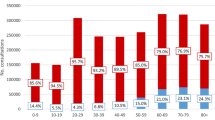Abstract
In July 2008, in France, guidelines for antibiotic prescriptions for urinary tract infections (UTIs) were amended. As general practitioners (GPs) treat numerous UTIs, we wanted to evaluate whether they followed these guidelines. In order to do this, we performed a prospective study. The point of call was urinalyses. Using this selection method together with criteria diagnostic for urinalysis, we confirmed that patients presented a UTI. Each GP was contacted. Prescriptions were analysed and compared to the 2008 French guidelines for UTIs. Our study included 185 urinalyses. UTIs diagnosed by GPs were as follows: acute cystitis: 72.4 %, prostatitis: 13.5 %, nephritis: 8.7 % and asymptomatic bacteriuria: 5.4 %. The principal antibiotics used were: quinolone (59.5 %), furan (17.8 %) and cotrimoxazole (6.5 %). Only 20 % of the prescriptions were compliant with the guidelines. The correct antibiotic but not the dose or the duration of prescription was selected in 8.1 % of the prescriptions. For cystitis, inappropriate prescription was associated with an extra cost of 694 €, namely, 7.4 € per treatment. GP prescriptions for UTIs do not follow the guidelines. Even if GPs assert that they are aware of the emergence of resistant strains, it seems that they do not take into account the objective of quinolone restriction, which was one of the backbones of these guidelines.


Similar content being viewed by others
References
Masiero G, Filippini M, Ferech M, Goossens H (2010) Socioeconomic determinants of outpatient antibiotic use in Europe. Int J Public Health 55(5):469–478
van de Sande-Bruinsma N, Grundmann H, Verloo D, Tiemersma E, Monen J, Goossens H, Ferech M; European Antimicrobial Resistance Surveillance System Group; European Surveillance of Antimicrobial Consumption Project Group (2008) Antimicrobial drug use and resistance in Europe. Emerging Infect Dis 14(11):1722–1730
Mérens A, Servonnet A (2010) Mechanisms and epidemiology of fluoroquinolone resistance in 2010. Rev Francoph Lab 422:33–41
European centre for Disease Prevention and Control (ECDC) (2012) Susceptibility of Enterococcus faecalis isolates to aminopenicillins in participating countries in 2010. Available online at: http://www.ecdc.europa.eu/en/activities/surveillance/EARS-Net/database/Pages/table_reports.aspx. Accessed 5 Feb 2012
AFSSAPS (Agence française de sécurité sanitaire des produits de santé) (2008) AFSSAPS Practice recommendations for diagnosis and antibiotic therapy of adult community urinary tract infections. Méd Mal Infect 38(Suppl 3):S203–S252
Llor C, Rabanaque G, López A, Cots JM (2011) The adherence of GPs to guidelines for the diagnosis and treatment of lower urinary tract infections in women is poor. Fam Pract 28(3):294–299
Kahan NR, Friedman NL, Lomnicky Y, Hemo B, Heymann AD, Shapiro M, Kokia E (2005) Physician speciality and adherence to guidelines for the treatment of unsubstantiated uncomplicated urinary tract infection among women. Pharmacoepidemiol Drug Saf 14(5):357–361
Taur Y, Smith MA (2007) Adherence to the Infectious Diseases Society of America guidelines in the treatment of uncomplicated urinary tract infection. Clin Infect Dis 44(6):769–774
McEwen LN, Farjo R, Foxman B (2003) Antibiotic prescribing for cystitis: how well does it match published guidelines? Ann Epidemiol 13(6):479–483
Grover ML, Bracamonte JD, Kanodia AK, Bryan MJ, Donahue SP, Warner AM, Edwards FD, Weaver AL (2007) Assessing adherence to evidence-based guidelines for the diagnosis and management of uncomplicated urinary tract infection. Mayo Clin Proc 82(2):181–185
Kahan NR, Kahan E, Waitman D-A, Chinitz DP (2004) Economic evaluation of an updated guideline for the empiric treatment of uncomplicated urinary tract infection in women. Isr Med Assoc J 6(10):588–591
Agdestein B, Lindbæk M, Gjelstad S (2011) Do general practitioners follow the national guidelines for treating urinary tract infections with antibiotics? Tidsskr Nor Laegeforen 131(17):1641–1644
Stein GE, Schooley S (2004) Urinary concentrations and bactericidal activities of newer fluoroquinolones in healthy volunteers. Int J Antimicrob Agents 24(2):168–172
Bush LM, Chaparro-Rojas F, Okeh V, Etienne J (2011) Cumulative clinical experience from over a decade of use of levofloxacin in urinary tract infections: critical appraisal and role in therapy. Infect Drug Resist 4:177–189
Kahan NR, Chinitz DP, Kahan E (2004) Longer than recommended empiric antibiotic treatment of urinary tract infection in women: an avoidable waste of money. J Clin Pharm Ther 29(1):59–63
Schmiemann G, Kniehl E, Gebhardt K, Matejczyk MM, Hummers-Pradier E (2010) The diagnosis of urinary tract infection: a systematic review. Dtsch Arztebl Int 107(21):361–367
de Saint Aubin H (2008) Prise en charge des infections urinaires en médecine générale: état des connaissances et étude de pratique par entretiens confraternels auprès de 57 médecins généralistes de Haute-Normandie
Bosch FJ, van Vuuren C, Joubert G (2011) Antimicrobial resistance patterns in outpatient urinary tract infections—the constant need to revise prescribing habits. S Afr Med J 101(5):328–331
Conflict of interest
There is no conflict of interest.
Financial disclosure
No financial support was received for the study.
Author information
Authors and Affiliations
Corresponding author
Rights and permissions
About this article
Cite this article
Denes, E., Prouzergue, J., Ducroix-Roubertou, S. et al. Antibiotic prescription by general practitioners for urinary tract infections in outpatients. Eur J Clin Microbiol Infect Dis 31, 3079–3083 (2012). https://doi.org/10.1007/s10096-012-1668-9
Received:
Accepted:
Published:
Issue Date:
DOI: https://doi.org/10.1007/s10096-012-1668-9




